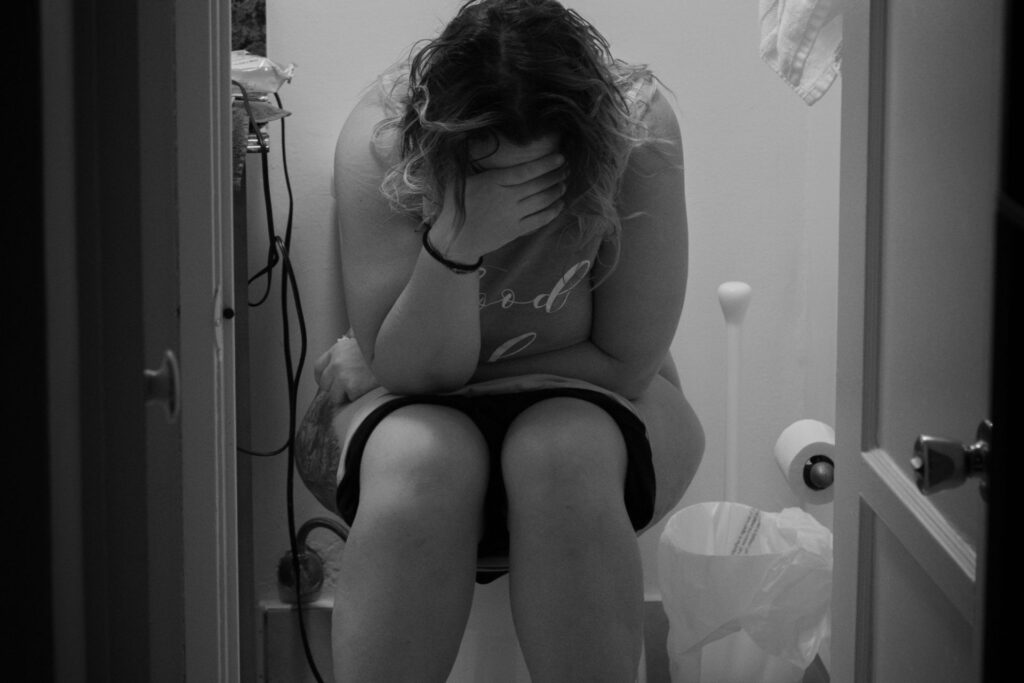1/2 hour to 2 or more hours
During the second stage of labour, the cervix dilates fully and the baby is born!
You may:
- Have a renewed sense of energy and excitement.
- Need to regroup after the intensity of transitional labour.
- Not feel the urge to push right away.
- Hold your breath when pushing or allow some breath to release, letting out a sound as you push. As long as your baby’s heartbeat is stable, there is no rush to push your baby out. It may take a while before you feel you’ve ‘got the hang of it,’ but you’ll gain confidence.
- Be surprised by the overwhelming urge to push (bear down) with contractions.
- Enjoy bearing down, or find it painful.
- Be tired, especially as this labour stage progresses, and sleep in between contractions.
- Be frightened by the intense rectal pressure of fullness, and resist bearing down.
- Continue to have lower back pain.
- Be embarrassed about passing some stool.
Find the following positions comfortable and effective:
- Semi-sitting at a 45-degree angle or more.
- Side-lying; useful for severe hemorrhoids or unusually fast delivery; this position allows you to watch the baby's birth.
- Hands and knees. (Excellent for back pain, and may help posterior baby turn.)
- Squatting – this increases the diameter of the pelvis. (Especially helpful when there has been little or no progress.)
- Sitting on toilet; useful because of the association with ‘letting go.’
Second-Stage Contractions
- Are generally much less painful.
- May occur every two to five minutes, and last approximately 60 seconds.
- May come in waves.
- Push the baby down through the open cervix.
- Help baby finish turning to face mother’s back (this starts in the first stage). The shape of the pelvis is such that the baby can get through more easily with its head in a front-to-back position.
In your body
- Baby’s head slips out of the fully dilated cervix, leaving room at the top of the uterus. It may take a few minutes for the uterus to become taut again around the rest of the baby’s body – this is why there is sometimes a lack of urge to push upon full dilation.
- Baby’s oxygen level affected if you hold your breath during pushing. Safe level is maintained when a new breath is taken at least every six to eight seconds.
- Eventually, the baby's nearly born head causes the perineum to bulge and the vaginal lips to part when the mother pushes. The head becomes visible when it is low enough.
- The baby's head recedes out of sight in between pushing efforts.
- Eventually, baby’s head fully opens vaginal lips and does not recede. This ‘crowning’ is characterized by an intense stretching and burning sensation known as ‘rim of fire.’
- Perineal tissue is vulnerable to tearing at crowning. ‘Rim of fire’ sensation can be seen as nature’s way of discouraging the mother from pushing at this time, decreasing the likelihood of tearing.
- Baby’s shoulders follow; the rest of the body is born.
The medical staff/midwife may
- Put a hand on your abdomen to feel when contractions occur.
- May encourage you to push during contractions and offer guidance/instructions.
- Examine you vaginally while pushing to feel the baby’s head.
- Stretch perineal tissue with U-shaped massaging motions and warm compresses; this helps avoid tearing and is sometimes done instead of episiotomy.
- Perform episiotomy. Regional anaesthetic is given if needed, unless you have had an epidural.
- Check fetal heart rate more frequently.
Nancy Levy, RN, MS, is a former childbirth educator at Women’s College Hospital in Toronto and York Central Hospital in Richmond Hill, Ont.









